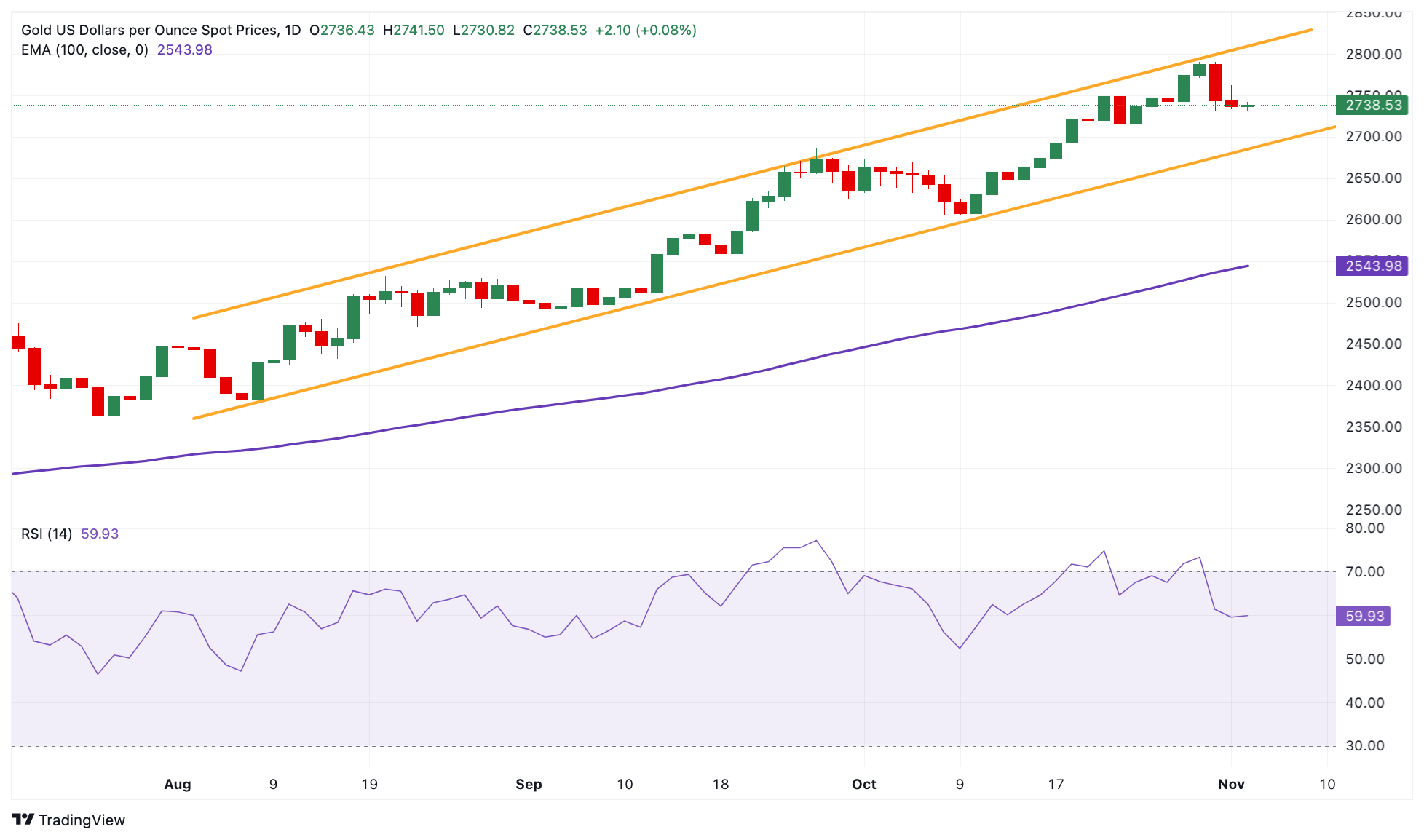- The price of Gold rises in the Asian session on Monday.
- Safe haven demand amid the uncertainties of the US presidential election and lingering tensions in the Middle East could boost the price of Gold.
- Traders prepare for the outcome of the US election on Tuesday ahead of the Fed’s rate decision.
The price of Gold (XAU/USD) is trading in positive territory on Monday. Risks from the US presidential election and ongoing geopolitical tensions in the Middle East will likely underpin the yellow metal, a traditional safe-haven asset, in the near term. However, renewed demand for the dollar and higher US bond yields could limit the rise in the price of gold, as higher yields make non-yielding assets like gold less attractive in comparison.
Investors will closely watch the impending US presidential election on Tuesday. Attention will shift to the US Federal Reserve’s (Fed) rate decision on Thursday. Uncertainty over the outcome of the US election is one reason why markets assume the Fed will cut rates by the usual 25 basis points (bps) on Thursday, rather than repeating its big half point cutout.
Daily Market Summary: Gold Price Remains Strong Ahead of US Presidential Election
- “ETFs are expected to see more inflows due to expected interest rate cuts, high fiscal deficits and highly valued stock markets. However, investment demand in the fourth quarter could be strongly influenced by the outcome of the US elections Central bank gold purchases will likely be strong again this year, but not at the levels seen in the previous two years. Jewelry demand is also expected to be lower than last year, although. somewhat larger than the WGC previously expected,” Commerzbank analysts noted.
- PredictIt has placed a 51% chance of a Harris victory on Tuesday, marking the vice president’s first lead over Trump (who leads Harris with a 49% chance) on the site since October 9.
- US nonfarm payrolls (NFP) increased by 12,000 in October, the smallest increase since December 2020. This figure followed the increase of 223,000 (revised from 254,000 seen in September) and was well below market consensus of 113,000.
- The unemployment rate remained unchanged at 4.1% in October, matching expectations.
- Financial markets have fully priced in a 25 basis point (bps) rate cut by the US Federal Reserve (Fed) at its November meeting on Thursday.
Technical Analysis: The price of Gold maintains the long-term upward trend
The price of Gold rises on the day. The positive picture of the precious metal prevails as the price remains above the 100-day EMA on the daily chart. Furthermore, the 14-day Relative Strength Index (RSI) is trading above the 50-midline near 60.20, suggesting that the support level is likely to hold rather than break.
More green candles above the all-time high and the psychological mark in the $2,790-2,800 zone could push XAU/USD to $2,850.
On the other hand, consistent trading below $2,715, the October 24 low, could drag the yellow metal to $2,624, the September 30 low, followed by the round $2,600 mark.
Gold FAQs
Gold has played a fundamental role in human history, as it has been widely used as a store of value and medium of exchange. Today, apart from its brilliance and use for jewelry, the precious metal is considered a safe-haven asset, meaning it is considered a good investment in turbulent times. Gold is also considered a hedge against inflation and currency depreciation, since it does not depend on any specific issuer or government.
Central banks are the largest holders of Gold. In their aim to support their currencies in turbulent times, central banks tend to diversify their reserves and purchase Gold to improve the perception of strength of the economy and currency. High Gold reserves can be a source of confidence for the solvency of a country. Central banks added 1,136 tons of gold worth about $70 billion to their reserves in 2022, according to data from the World Gold Council. This is the largest annual purchase since records exist. Central banks in emerging economies such as China, India and Türkiye are rapidly increasing their gold reserves.
Gold has an inverse correlation with the US Dollar and US Treasuries, which are the main reserve and safe haven assets. When the Dollar depreciates, the price of Gold tends to rise, allowing investors and central banks to diversify their assets in turbulent times. Gold is also inversely correlated with risk assets. A rally in the stock market tends to weaken the price of Gold, while sell-offs in riskier markets tend to favor the precious metal.
The price of Gold can move due to a wide range of factors. Geopolitical instability or fear of a deep recession can cause the price of Gold to rise rapidly due to its status as a safe haven asset. As a non-yielding asset, the price of Gold tends to rise when interest rates fall, while rising money prices tend to weigh down the yellow metal. Still, most of the moves depend on how the US Dollar (USD) performs, as the asset is traded in dollars (XAU/USD). A strong Dollar tends to keep the price of Gold in check, while a weaker Dollar is likely to push up Gold prices.
Source: Fx Street
I am Joshua Winder, a senior-level journalist and editor at World Stock Market. I specialize in covering news related to the stock market and economic trends. With more than 8 years of experience in this field, I have become an expert in financial reporting.








